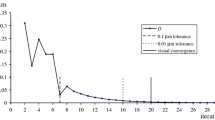Abstract
According to ISO 3274 form errors can be removed by fitting a polynomial regression through the original measured data called the total profile to obtain the primary profile. For wood surfaces it was found that the regression was affected by the presence of deep and grouped pores.
To obtain a primary profile free of distortion, the deep pores can be removed from the total profile prior to applying the regression. A method was developed that eliminated the pores entirely. The efficacy of this method was tested visually and by comparing coefficients of determination r2 between the polynomial regression according to ISO 3274 (1996) and the total profile and the modified regression line when the effect of deep pores was removed and the modified profile that had no pores.
The influence of the shape of the primary profile obtained by the standard method in ISO 3274 (1996) on further digital processing was tested on roughness profiles filtered with a Robust Gaussian Regression Filter. The undistorted primary profile was taken as a reference.
Zusammenfassung
Gemäß ISO 3274 können grobe Porenrillen ausgeschaltet werden, indem eine Polynomfunktion an die Rohdaten, das so genannte Gesamtprofil, angepasst wird, um das Primärprofil zu erhalten. Es hat sich gezeigt, dass bei Holzoberflächen die Regression durch tiefe Poren beeinflusst wurde. Um ein ungestörtes Primärprofil zu erhalten, wurden die tiefen Poren vor Durchführung der Regressionsanalyse vom Gesamtprofil entfernt. Eine Methode, welche die Poren vollkommen ausschließt, wurde entwickelt. Die Wirksamkeit dieser Methode wurde sowohl visuell geprüft als auch durch Vergleich des Bestimmtheitsmaßes r2 zwischen der Regressionskurve nach ISO 3274 (1996) und dem Gesamtprofil sowie zwischen der Regressionskurven, die sich bei Verwendung der Methode mit vorheriger Ausschaltung der Poren ergaben, und dem modifizierten porenfreien Profil.
Der Einfluss der Form des Primärprofils nach dem Standardverfahren gemäß ISO 3274 (1996) auf die weitere Bearbeitung wurde an Rauhigkeitsprofilen überprüft, die mit einem robusten Gaußfilter gefiltert wurden. Das ungestörte Primärprofil diente als Referenzprofil.
Similar content being viewed by others
References
ASME B46.1 (1995) Surface Texture. Surface Roughness, Waviness, Lay. ASME B46 Committee
Fujiwara Y, Fujii Y, Okumura S (2003) Robust Gaussian Filter and Three-Dimensional Parameters to Evaluate Wood Surface Roughness as Related to Tactile Roughness. In: Proc. of the 16th International Wood Machining Seminar. August 2003, Matsue, Japan
Gurau L (2004) The Roughness of Sanded Wood Surfaces. Doctoral thesis. Forest Products Research Centre. Buckinghamshire Chilterns University College, Brunel University
Gurau L, Mansfield-Williams H, Irle M (2002) An analysis of wood surface roughness data. In: Proc. of the 13th International Symposium on Non-destructive Testing of Wood. Ed. Beall, F.C. 19–21 August 2002, University of California, Berkeley Campus, California, USA
Gurau L, Mansfield-Williams H, Irle M (2005). Processing roughness of sanded wood surfaces. Holz Roh- Werkst 63(1):43–52
Gurau L, Mansfield-Williams H, Irle M (2006). Filtering the roughness of a sanded wood surface. Holz Roh- Werkst 64(5):363–371
ISO 11562 (1996) Geometrical product specifications (GPS). Surface texture. Profile method. Metrological characteristics of phase correct filters. International Standards Organisation
ISO 13565-1 (1996) Geometrical product specifications (GPS). Surface texture. Profile method. Surfaces having stratified functional properties. Part 1: Filtering and general measurement conditions. International Standards Organisation
ISO 13565-3 (2000) Geometrical product specification (GPS).Profile method. Surfaces having stratified functional properties. International Standards Organisation
ISO 3274 (1996) Geometrical product specifications (GPS). Surface texture. Profile method. Nominal characteristics of contact (stylus) instruments. International Standards Organisation
ISO 4287 (1998) Geometrical product specifications (GPS). Surface texture. Profile method. Terms. Definitions and surface texture parameters. International Standards Organisation
ISO/DTS 16610-31 (2002(E)) Geometrical product specification (GPS). Filtration Part 31: Robust profile filters. Gaussian regression filters. In Draft. International Standards Organisation
Krisch J, Csiha C (1999) Analysing wood surface roughness using an S3P Perthometer and computer based data processing. In: Proc. XIII Sesja Naukowa “Badania dla Meblarstwa”, Poland
Mathcad 2000. Reference Manual (1999) MathSoft, Cambridge, ISBN 1-57682-105-6
Westkämper E, Schadoffsky O (1995) Oberflächentopographie von Massivholz. Einflüsse und Verfahren bei der Meßtechnischen Erfassung und Bewertung von Holzoberflächen, Teil 2. HOB Holzbearbeitung 4:50–54
Author information
Authors and Affiliations
Corresponding author
Rights and permissions
About this article
Cite this article
Gurau, L., Mansfield-Williams, H., Irle, M. et al. Form error removal of sanded wood surfaces . Eur. J. Wood Prod. 67, 219–227 (2009). https://doi.org/10.1007/s00107-009-0310-8
Received:
Published:
Issue Date:
DOI: https://doi.org/10.1007/s00107-009-0310-8




